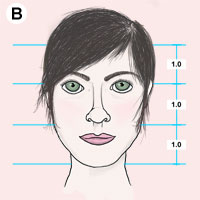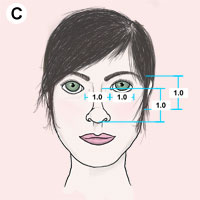The Beauty Equation
During the European Renaissance, renowned artists and architects used an equation known as the "golden ratio" to map out their masterpieces. Thousands of years later, scientists adopted this mathematical formula to help explain why some people are considered beautiful...and others are not.
Dr. Kendra Schmid, an assistant professor of biostatistics, uses the golden ratio and 29 other measurements to study facial sex appeal. These measurements are calculated to determine a person's beauty on a scale of 1 to 10. What does she measure?
 A. First, Dr. Schmid measures the length and width of the face. Then, she divides the length by the width. The ideal result—as defined by the golden ratio—is roughly 1.6, which means a beautiful person's face is about 1 1/2 times longer than it is wide.
A. First, Dr. Schmid measures the length and width of the face. Then, she divides the length by the width. The ideal result—as defined by the golden ratio—is roughly 1.6, which means a beautiful person's face is about 1 1/2 times longer than it is wide.
 B. Next, Dr. Schmid measures three segments of the face—from the forehead hairline to a spot between the eyes, from between the eyes to the bottom of the nose, and from the bottom of the nose to the bottom of the chin. If the numbers are equal, a person is considered more beautiful.
B. Next, Dr. Schmid measures three segments of the face—from the forehead hairline to a spot between the eyes, from between the eyes to the bottom of the nose, and from the bottom of the nose to the bottom of the chin. If the numbers are equal, a person is considered more beautiful.
 C. Finally, statisticians measure other facial features to determine symmetry and proportion. On a perfect face, Dr. Schmid says the length of an ear is equal to the length the nose, and the width of an eye is equal to the distance between the eyes.
C. Finally, statisticians measure other facial features to determine symmetry and proportion. On a perfect face, Dr. Schmid says the length of an ear is equal to the length the nose, and the width of an eye is equal to the distance between the eyes.
Most people score between 4 and 6, and Dr. Schmid says no one has ever been a perfect 10.
How do you measure true beauty? Leave a comment below.
Dr. Kendra Schmid, an assistant professor of biostatistics, uses the golden ratio and 29 other measurements to study facial sex appeal. These measurements are calculated to determine a person's beauty on a scale of 1 to 10. What does she measure?
 A. First, Dr. Schmid measures the length and width of the face. Then, she divides the length by the width. The ideal result—as defined by the golden ratio—is roughly 1.6, which means a beautiful person's face is about 1 1/2 times longer than it is wide.
A. First, Dr. Schmid measures the length and width of the face. Then, she divides the length by the width. The ideal result—as defined by the golden ratio—is roughly 1.6, which means a beautiful person's face is about 1 1/2 times longer than it is wide. B. Next, Dr. Schmid measures three segments of the face—from the forehead hairline to a spot between the eyes, from between the eyes to the bottom of the nose, and from the bottom of the nose to the bottom of the chin. If the numbers are equal, a person is considered more beautiful.
B. Next, Dr. Schmid measures three segments of the face—from the forehead hairline to a spot between the eyes, from between the eyes to the bottom of the nose, and from the bottom of the nose to the bottom of the chin. If the numbers are equal, a person is considered more beautiful.  C. Finally, statisticians measure other facial features to determine symmetry and proportion. On a perfect face, Dr. Schmid says the length of an ear is equal to the length the nose, and the width of an eye is equal to the distance between the eyes.
C. Finally, statisticians measure other facial features to determine symmetry and proportion. On a perfect face, Dr. Schmid says the length of an ear is equal to the length the nose, and the width of an eye is equal to the distance between the eyes.Most people score between 4 and 6, and Dr. Schmid says no one has ever been a perfect 10.
How do you measure true beauty? Leave a comment below.
Illustrations by David Stinnette



